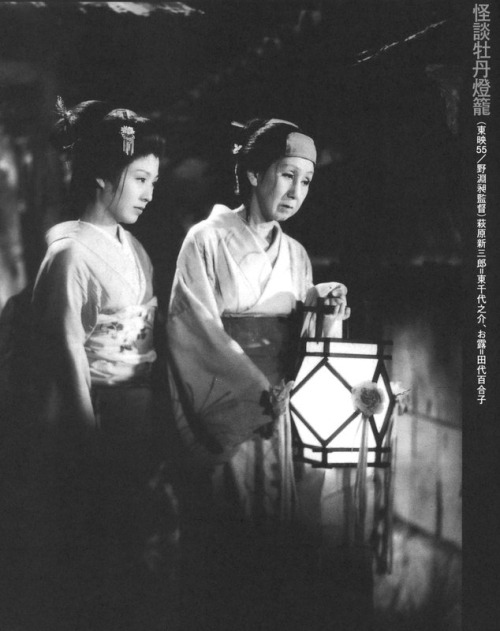Japan Folklore: Botan Dōrō
Botan Dōrō
La Lanterna di Peonie
 Photo credits: allabout-japan.com
Photo credits: allabout-japan.com
Esistono molte storie dove amanti sfortunati sono divisi dal destino, a volte arrivando insieme alla morte (Romeo e Giulietta e Tristano ed Isotta le più famose). Ma nessuna è come la storia Botan Dōrō o La lanterna di Peonie (牡丹燈籠). Due innamorati divisi dal regno dei vivi e quello dei morti sono indissolubilmente legati dal loro giuramento d’eterno amore.
Questa leggenda vede la luce nel libro Jiandeng Xinhua scritto da Qu You durante la prima parte della dinastia Ming. Successivamente, venne poi riproposta durante il periodo Edo dallo scrittore e prete buddista Asai Ryōi sull’onda del fenomeno Kaidan (怪談). Questo termine giapponese indica tutte quelle storie che narrano di mistero e fantasmi, scritto con due kanji: Kai( 怪)che significa “strano, misterioso, apparizione incantata” e Dan (談)“narrazione recitata”.
Questa leggenda va riconosciuta come una delle prime storie giapponesi riguardanti i fantasmi a diventare film nel 1910. Con numerose riedizioni durante gli anni, è forse una più produttive tra cinema, adattamenti televisivi e Pink Movie, genere Soft Porno Giapponese.
La bella Otsuyu
 Photo credits: pinterest.com
Photo credits: pinterest.com
La leggenda narra che durante la prima notte dell’ Obon (la commemorazione dei defunti secondo la tradizione Buddista Giapponese) il samurai Ogiwara Shinnojo incontra una bellissima donna e una bambina sua serva. In mano le due hanno lanterne di peonie, come vuole l’usanza, e il samurai chiede alla bimba il nome della splendida donna. Otsuyu era il suo nome ed il samurai non fu in grado di fare altro se non innamorarsene perdutamente e giurarle amore eterno quella sera stessa. Da li in poi, tutte le sere i due si incontrano bruciando di passione l’uno per l’altra. Tuttavia, durante le prime ore del mattino la bella donna e la bambina sparivano. A causa di questo comportamento sospetto, ed anche per via di una malattia improvvisa dell’uomo, un anziano vicino si incuriosisce. Entrando in casa sua, scopre che il samurai non giaceva a letto con una bellissima donna ma con uno scheletro! L’anziano vicino avvisa dunque un prete che a sua volta avvisa Ogiwara, il quale scopre così che l’amata è in realtà un fantasma. Ogiwara capisce anche che la sua malattia era dovuta al fatto che dormire con uno spirito consuma l’energia vitale di una persona. Il prete benedice l’abitazione del samurai lasciando incantesimi protettivi e portafortuna affinché la donna e la bambina non possano più entrare. La sera stessa la donna cerca invano di raggiungere l’amato ma, non riuscendovi, urla disperata il suo amore per Ogiwara che alla fine cede lasciandola entrare in casa. La mattina dopo, il vicino ed il prete trovano Ogiwara morto stringendo a sè lo scheletro di Otsuyu.
Dallo stile macabro del periodo Edo al romanticismo di quello Meiji
 Photo credits: tumblr.com
Photo credits: tumblr.com
Di questa storia è molto famosa la versione del teatro Kabuki, ma c’è una sostanziale differenza tra le due. Nella versioni teatrale infatti i protagonisti si conoscono prima della morte di Otsuyu. Le loro famiglie sono molto vicine da tempo e questo aveva favorito la nascita dell’amore tra i due. Questa versione è la più conosciuta proprio per il romanticismo pregnante dall’inizio alla fine. Il loro amore, la passione giovanile, e poi la delusione per un distacco forzato dovuto per un periodo alla malattia del ragazzo. Durante questo periodo di separazione Otsuyu muore convinta che Saburo non fosse sopravvissuto alla malattia. Saburo invece si riprende e disperato per la morte della ragazza prega il suo spirito durante la festa dell’Obon. Quella sera stessa, tornando a casa, incontra sul suo cammino una donna e la sua serva con in mano una lanterna di peonie. Con sua grande gioia il giovane si accorge che quella donna è proprio la sua Otsuyu che da quella notte in poi, tutte le notti, andrà a fargli visita. Ma la gioia durerà poco. Infatti, un servo, spiando da una fessura nel muro della stanza di Saburo, si accorge che in realtà egli giaceva ogni notte con uno scheletro. Un prete buddista viene subito avvertito e alle porte della casa vengono affissi dei talismani per impedire allo spirito di entrare. Eppure, ogni notte la fanciulla torna per gridare il suo amore per Saburo che, disperato per la nuova separazione, si ammala nuovamente. Ma la consapevolezza di amarla comunque e nonostante tutto significa una sola cosa. La morte! I talismani vengono rimossi per permettere allo spirito di entrare ancora una volta. L’ultima. Il giovane protagonista però muore felice tra le braccia di colei che ama.
Questa differenza di temi si può attribuire al diverso periodo in cui sono state scritte le due versioni. Quella originale risale al periodo Edo con la vena macabra che caratterizza il folclore Giapponese dell’epoca. Quella teatrale invece è più recente e vede la luce nel periodo Meiji, ovvero il periodo in cui il Giappone si avvicina all’occidente grazie all’apertura dell’imperatore Mutsuhito. Apertura che non si verificò solo a livello politico, ma anche a livello culturale influenzando quindi gusti e costumi, e questa leggenda ne è un esempio.
Condividi:
- Fai clic per condividere su Facebook (Si apre in una nuova finestra)
- Fai clic qui per condividere su Twitter (Si apre in una nuova finestra)
- Fai clic qui per condividere su Tumblr (Si apre in una nuova finestra)
- Fai clic qui per condividere su Pinterest (Si apre in una nuova finestra)
- Fai clic per condividere su Telegram (Si apre in una nuova finestra)
- Fai clic per condividere su WhatsApp (Si apre in una nuova finestra)
- Fai clic qui per condividere su Reddit (Si apre in una nuova finestra)
- Fai clic qui per stampare (Si apre in una nuova finestra)






